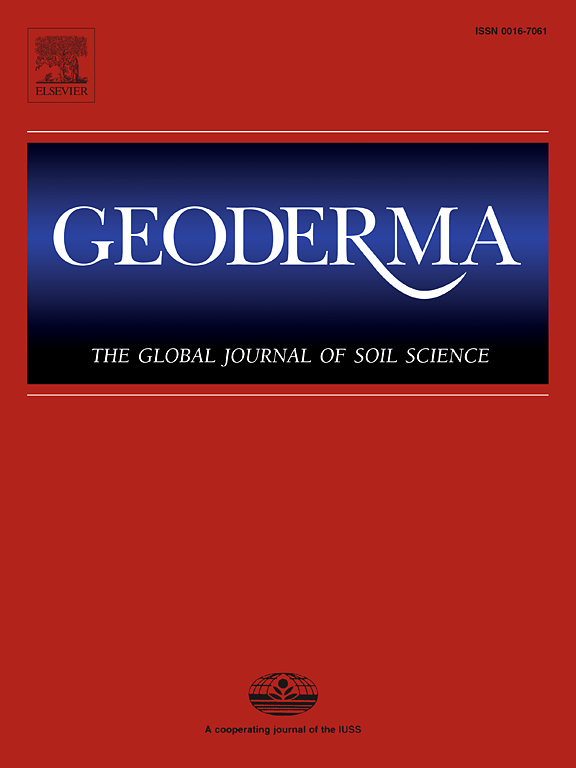Continuous cropping obstacles: Insights from the community composition and the imbalance carbon fluxes within soil nematode food web
IF 5.6
1区 农林科学
Q1 SOIL SCIENCE
引用次数: 0
Abstract
Long-term continuous cropping can lead to the deterioration of soil environment and the decrease of soil productivity. However, the biological mechanism on the negative effects of long-term continuous cropping has not been extensively explored. Soil nematode food web with multiple trophic levels play critical roles in nutrient cycling and energy flowing in the agroecosystem. Quantifying the carbon flux through different trophic channels within the nematode food web can indicate how continuous cropping influences carbon cycling in the agroecosystem by altering soil biota communities. Therefore, the effects of continuous peanut cropping with different years (1, 5, 20, and 30 years) on soil properties, soil nematode community composition, carbon flux within nematode food web and crop yields were investigated. Results showed that soil pH significantly decreased with increasing continuous cropping years. Differently, soil organic carbon and total nitrogen were the highest in 20-year, and decreased in 30-year of continuous cropping. As continuous cropping years increased, the relative abundance of microbivorous nematodes decreased and that of plant parasites reached as high as 76.11 % and 68.22 % in 20- and 30-year, respectively. Pearson correlation analysis revealed the nematode diversity, the carbon flux uniformity and peanut yield had a significant negative correlation with continuous cropping years. The random forest model indicated that the soil pH and the relative abundance of plant parasites were the key influence factor of the carbon flux uniformity within soil nematode food web. Outbreaks of plant parasites lead to the disruption of carbon flux uniformity within soil nematode food web, which can increase the risk of peanut yield decline after long-term continuous cropping. In conclusion, continuous peanut cropping changed soil properties, reduced soil nematode diversity, and disturbed the multitrophic carbon flux complementarity and uniformity in soil nematode food web, ultimately limiting the crop productivity. This study enhances our understanding of the importance of the resource transfers among soil food web in maintaining sustainable agroecosystem productivity.
连作障碍:从土壤线虫食物网的群落组成和不平衡碳通量中获得的启示
长期连作会导致土壤环境恶化和土壤生产力下降。然而,长期连作负面影响的生物机制尚未得到广泛探讨。具有多个营养级的土壤线虫食物网在农业生态系统的养分循环和能量流动中发挥着关键作用。量化线虫食物网中不同营养渠道的碳通量,可以说明连作如何通过改变土壤生物群落来影响农业生态系统的碳循环。因此,研究了不同年份(1 年、5 年、20 年和 30 年)连续种植花生对土壤特性、土壤线虫群落组成、线虫食物网内碳通量和作物产量的影响。结果表明,随着连续种植年限的增加,土壤 pH 值明显下降。不同的是,土壤有机碳和全氮在连作 20 年时最高,在连作 30 年时下降。随着连作年限的增加,微食线虫的相对丰度下降,植物寄生虫的相对丰度在 20 年和 30 年分别高达 76.11 % 和 68.22 %。皮尔逊相关分析表明,线虫多样性、碳通量均匀性和花生产量与连续种植年限呈显著负相关。随机森林模型表明,土壤 pH 值和植物寄生虫的相对丰度是影响土壤线虫食物网碳通量均匀性的关键因素。植物寄生虫的爆发会导致土壤线虫食物网内碳通量均匀性的破坏,从而增加长期连作后花生产量下降的风险。总之,花生连作改变了土壤性质,降低了土壤线虫多样性,扰乱了土壤线虫食物网的多营养碳通量互补性和均匀性,最终限制了作物产量。这项研究加深了我们对土壤食物网之间的资源转移在维持可持续农业生态系统生产力方面的重要性的认识。
本文章由计算机程序翻译,如有差异,请以英文原文为准。
求助全文
约1分钟内获得全文
求助全文
来源期刊

Geoderma
农林科学-土壤科学
CiteScore
11.80
自引率
6.60%
发文量
597
审稿时长
58 days
期刊介绍:
Geoderma - the global journal of soil science - welcomes authors, readers and soil research from all parts of the world, encourages worldwide soil studies, and embraces all aspects of soil science and its associated pedagogy. The journal particularly welcomes interdisciplinary work focusing on dynamic soil processes and functions across space and time.
 求助内容:
求助内容: 应助结果提醒方式:
应助结果提醒方式:


